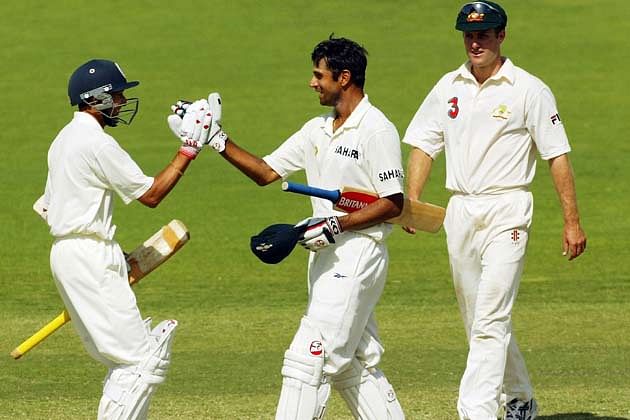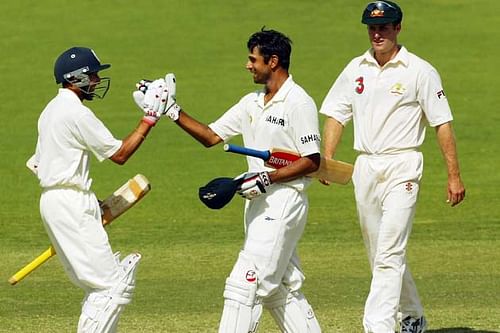
An ode to Australia vs India 2003-04 - Part 1

As a bonafide stickler for storytelling, I love it when cricket tells a story. It adds so much depth to a rudimentary bat and ball game and gets nations invested with all their hearts – so much so that a victory is treated with an exuberant celebration tantamount to an Independence Day one.
The Australia vs India Border-Gavaskar series of 2003-04, was in my eyes, one of the most brilliant ones in cricketing history. If you look back at the squads today, you would rank all men as legends. Justin Langer, Matthew Hayden, Ricky Ponting, Steve Waugh, Adam Gilchrist, Virender Sehwag, Sachin Tendulkar, Rahul Dravid, Sourav Ganguly, VVS Laxman, Anil Kumble – all glorified legends of a lost era.
This wasn’t a time when they were establishing themselves either – all of them were renowned in Test cricket for their proficiency and were long-standing icons of the game. India, crudely hurt by Australia’s thrashing in the only two matches they lost in the 2003 World Cup, and sored by the poison of their poor overseas Test match record, had something to fight for. Australia, on the other hand, undisputed champions of the world, looked at it as a fitting goodbye to their retiring leader Waugh.
With such history in the lead up, these teams met head to head to create cricketing gold.
First Test, Brisbane Cricket Ground (Gabba)
If there was ever a sporting killjoy, it would be the first Test at Brisbane. Justin Langer stroked his way to a hundred, and India seemed back on track with their overseas routine. Minimal play due to unrelenting rain meant that by the fifth day, just the first innings for both teams had been completed.
Sourav Ganguly’s fighting knock ensured India stuck through and got a lead after Dravid and Tendulkar were dismissed in succession by Jason Gillespie. Australia replied quickly, with Hayden scoring 99, and the match ended tamely with India at 73 for 2 chasing 199.
Ganguly stood well above the rest, for tremendous display of grit after being sneered at and ridiculed for months with his approach to pace bowling. At times, the Indians got bogged down by numbers and records, so much so that people will grow to marvel Rohit Sharma’s 264 (with good reason), but not many would remember the absolutely fantastic 144 by Ganguly. But they should, for it stands in a league of its own.
One of the biggest disappointments was Waugh, adorned to be farewelled like a king, who ended up hitting his own wicket. It didn’t help that Damien Martyn had sacrificed himself for his captain after a mix-up earlier.
Second Test, Adelaide Oval
India walked into the second match with a chip on their shoulders of having held their own at the Gabba. They then proceeded to settle down and watch Australia annihilate their bowling throughout the first two days, with 400 runs scored on day one itself. The display of bravado was dampened and all embodiments of confidence were shattered. The Great Indian Overseas Annihilation had begun, once again.
The regular fall of wickets undeterred the rate of scoring, for Australia seemed to be hurt at India’s slight display of aggression at the Gabba, and went out to prove to the world why they were world champions. Ponting would’ve been the highlight of the match if not for one man from Team India, for he reigned supreme over the Indian bowling with the same dominance that he showed at Johannesburg earlier that year, leading Australia to a mammoth score of 556.
India tottered to 85 for 4, and the future was bleak. At the crease were Laxman and Dravid, two entities not unknown to Australia due to their heroics at Eden Gardens in 2001. What happened next was magic. They added 303, becoming the third pair to share two-300+ stands in Tests.
Watching Dravid and Laxman play cricket was like listening to a good old song, or watching a whimsical dance performance. The elegance in strokeplay, the unflappable temperament, and the stoic resilience would grow to haunt the Australian bowlers.
After Laxman departed at 148, Dravid carried on with the tail until he finally fell for 233, having carried India 33 short of Australia’s first innings score. Australia’s desire to reestablish control over the match through ruthless aggression failed miserably, as Ajit Agarkar led an unforeseen turnaround with a six-wicket haul. Having cluttered them out for 196, India were left at the brink of making history.
Rahul Dravid ensured India wouldn’t lose this miraculous opportunity, and once again took up the mantle of ‘The Wall’ and sealed the match for India, fittingly joined by Ajit Agarkar for the winning runs. The herculean effort that required over 800 minutes of batting and 305 runs, ensured Rahul Dravid cemented his legacy in the hearts and minds of all Indians.
India, despite immense skepticism prior to the series, had fought tooth and nail to their first ever Test match victory in Australia in 23 years. The veils of criticism were withdrawn, and for a short while it may be, the nation came together as one.
To be continued...